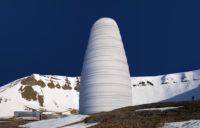The California Science Center in Los Angeles has begun the process of stacking the large components for a 100,000 sq-ft exhibit that will showcase the space shuttle Endeavour standing upright for public viewing. The first step in this six month-long project was the placement of the solid rocket booster aft "skirts" on July 20. These 13,000-lb skirts will serve as the foundation of the vertical shuttle stack.
The two cylindrical aft skirts were lifted by a 300-ton crane and placed on top of a seismic isolator pad in the shuttle gallery of the Samuel Oschin Air and Space Center. The skirts are 18 ft wide and 8 ft tall, and have a diameter of 18 ft at the base and 12 ft at the top.
Each aft skirt will be held in place by four hold-down studs made of a heavy-duty, nickel-chromium-based superalloy known as “inconel.” Each stud weighs about 900 lb and measures 9 ft in length. The studs must be precisely fastened within 1/10th-in. tolerances.
The vertical shuttle stack is part of an overall $400 million seismically-focused project at the Science Center that will showcase the iconic Endeavour in the 200,000 sq-ft building. The project, slated for completion in 2025, was designed by ZGF Architects, with Arup serving as structural engineer and MATT Construction leading construction. Evidence Design is in charge of exhibit design.
In 2012, the space shuttle made a 12-mile journey through Los Angeles streets from an airplane hangar to the science center. The trip required hundreds of hours of planning and engineering.
Two solid rocket motors will be stacked atop the skirts, followed by the forward assemblies. Next, the space shuttle’s external tank will be lifted into place, followed by the project’s centerpiece, the Endeavour, positioned vertically in a "ready for launch" configuration.
When complete, the exhibit will stand 200 ft tall and weigh approximately 500,000 lb.
Amie Nulman, associate principal with Arup, says the most challenging aspect of this part of the project was forming the base that the afts sit on. The seismic isolator pad is about 8 ft thick, 45 ft wide and 75 ft long and is built to support the entire weight of the 500,000-lb completed exhibit.
“The complication is that the exhibit is heavy and there are earthquakes in LA, so the ground is going to shake quite a bit and you have a 500,000-pound, 180-foot-tall exhibit moving around, experiencing lots of different forces and displacements, and the base it sits on has to be strong enough to keep it from rotating over,” she says.
To ensure stability and safety in an earthquake, the engineering team worked with ex-Boeing engineers from the space shuttle program and used a program called LS Dyna to run the structure through multiple earthquake scenarios. The six, triple-friction pendulum base isolators located beneath the space shuttle will allow for up to 30 inches of movement in a seismic event, according to Arup.
Project officials say this will be the world’s only display of an authentic, “ready-to-launch” space shuttle system.




Post a comment to this article
Report Abusive Comment